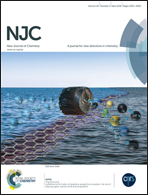Voltammetric deposition of BiCdTe composite films with improved functional properties for photo-electrochemical cells
Abstract
Polycrystalline semiconductor films of BiCdTe composites were electro-deposited on ITO coated glass through a voltammetric technique under variable periodic cycles. The crystal structure and composition of the films were determined by X-ray diffraction, scanning electron microscopy, atomic force microscopy and energy dispersive X-ray analysis and the optical features were recorded using a UV-visible spectrometer. The band gap energy of the ternary films was found to be within the range of 1.5–1.7 eV. Electrochemical impedance spectroscopy provided important information regarding the interfacial properties of the films in polysulphide medium. The current–voltage measurements for the photo-electrochemical solar cells fabricated with the prepared films as anode components exhibited encouraging photo-response and improved functional properties. The BiCdTe composite films were further subjected to anodic corrosion studies followed by anodic stripping voltammetry and the stability of the films was compared with that of CdTe. An optimal composition of the film matrix shows a performance efficiency of 4.3%, significantly high photo current and considerably greater stability compared to the individual binary chalcogenide films.


 Please wait while we load your content...
Please wait while we load your content...